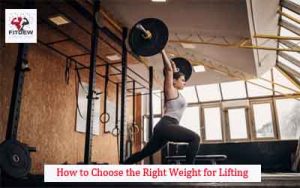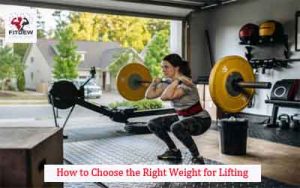When it comes to strength training, choosing the right weight is an important decision that can make or break your fitness journey.
Whether you are a beginner looking to start a weightlifting routine or an experienced lifter aiming to fine-tune your workouts, the weight you choose plays an extremely important role in determining the effectiveness and safety of your exercises.
In today’s post, we will talk about how to choose the right weight for lifting. It is very essential you read this content till the last dot especially if you are about to get started with weight lifting.
Choosing the perfect weight is not just about lifting the heaviest object in sight; it is about finding the balance between challenge and control, assisting you in achieving your fitness goals while preventing injury.
We will explore the key factors that influence this decision, including your individual fitness level, goals, and more. By the end of the discussion, you will be equipped with the knowledge needed to make wise weight choices and experience the most productive and rewarding strength training sessions. So, let’s get started on the journey to finding your perfect lifting weight. You can check out 7 Early Morning Exercise Benefits

Importance of choosing the right weight for lifting
Your selection of the right weight for lifting is important for several reasons, not minding whether you are engaging in strength training, weightlifting, or any other resistance exercise. You can check out here for 15 exercises that burn the most calories
Here are some of the reasons why selecting the right weight is important
Safety: Lifting a weight that is too heavy for your current strength level can result in injuries like muscle strains, joint problems, or even more severe issues like herniated discs. Also, lifting a weight that is too light may not provide the necessary stimulus for muscle growth and strength development.
Effective Progression: Choosing the right weight allows for progressive overload which is essential for making continuous gains in strength and muscle size. If the weight is too light, your body won’t be challenged enough to adapt and grow. If it is too heavy, you may not be able to complete the prescribed repetitions and sets, impeding your progress.
Muscle Development: Choosing the right weight ensures that you engage the target muscles effectively. If the weight is too light, you might rely on momentum and other muscles to complete the exercise, rather than focusing on the primary muscle groups you intend to work. On the other hand, an excessively heavy weight could lead to poor form and reduced muscle activation.
Workout Efficiency: Using the right weight allows you to achieve your training goals efficiently. This means you can complete your workout in a reasonable amount of time without unnecessary rest periods or time spent struggling with overly heavy weights.
Motivation: Lifting an appropriate weight that challenges you but is manageable can be motivating. You will see progress more quickly and this can boost your confidence and enthusiasm for your fitness journey.
Injury Prevention: Overloading with excessive weight not only increases the risk of immediate injuries but can also lead to overuse injuries over time. Consistently lifting weights that are too heavy for your capacity can strain your body and joints.
Skill Development: For exercises that require a degree of skill and technique (e.g., Olympic lifts or powerlifting), selecting the right weight is essential for mastering proper form and perfecting your technique. Starting too heavy can lead to poor form and bad habits.
Customization: The right weight is specific to your individual fitness level and goals. What is appropriate for one person may not be right for another. It depends on factors like your current strength, experience, and objectives.

How to Choose the Right Weight for Lifting
Selecting the right weight for lifting depends on various factors like your goals, experience level, and the specific exercise you are engaging in.
Here is a step-by-step guide to assist you in choosing the appropriate weight for your lifting routine
Determine Your Goals
Are you looking to build muscle, increase strength, or improve endurance?
Are you training for a specific sport or activity? Know your goals and then select the weights that suit your goals.
Assess Your Experience Level
Beginner: If you are new to weightlifting, begin with lighter weights to learn proper form and prevent injury.
Intermediate: If you have some experience, you can gradually increase the weight to challenge yourself.
Advanced: If you are an experienced lifter, you should have a good understanding of your capabilities.
Warm Up
Always begin with a warm-up to prepare your muscles and joints for lifting. This can include light cardio, dynamic stretching, and mobility exercises.
Choose the Right Exercise
Different exercises require different weight selections. For compound movements like squats, deadlifts, and bench presses, you will typically lift heavier weights than for isolation exercises.
Use the Repetition Range
Determine the number of repetitions (reps) you want to perform for your set. This will guide your weight selection.
Lower reps (1-5) with heavy weights are more suitable for strength gains.
Moderate reps (6-12) with moderate weights are often used for muscle hypertrophy (growth).
Higher reps (12+) with lighter weights can improve muscular endurance.
Consider Your 1-Rep Max (1RM)
If you know your 1RM for a specific exercise, you can use it as a reference point.
For strength, use a weight that is around 75-85% of your 1RM.
For hypertrophy, aim for weights around 60-75% of your 1RM.
For endurance, choose a weight that allows you to perform the desired number of reps with proper form.
Listen to Your Body
Pay attention to how the weight feels during your warm-up sets.
If a weight is too light and you can easily complete the prescribed reps, increase it.
If the weight is too heavy, causing you to compromise your form, reduce it to avoid injury.
Progressive Overload
To make progress, you must gradually increase the weight over time. This can be done by adding small increments (e.g., 2.5-5 lbs. or 1-2 kg) when the current weight becomes manageable.
Safety First
Always prioritize safety and proper form over lifting heavy weights. Lifting with poor form can lead to injury.
Record Your Progress
Keep a training log to track the weights you use, the number of reps and sets, and how the exercise feels. This will assist you in planning your future workouts.

How to Choose the Right Weight-Lifting Belt
Making your selection for the right weightlifting belt is essential for your safety and performance in the gym. Here are some steps to assist you in selecting the right weightlifting belt
Understand the Purpose
Weightlifting belts are designed to provide support and stability to your core during heavy lifts such as squats and deadlifts. They work by increasing intra-abdominal pressure, which can assist in protecting your lower back and improve lifting form. Consider your primary lifting goals and the type of exercises you will be performing.
Determine Your Belt Type
Weightlifting belts come in various types including powerlifting belts and Olympic-style belts. Powerlifting belts are wider in the back and taper down in the front offering more support for heavy compound movements like squats and deadlifts.
Olympic-style belts are usually narrower and designed for more dynamic lifts like cleans and snatches. Choose the type that suits your primary lifting style.
Check the Material
Weightlifting belts can be made from different materials including leather, suede, nylon, and synthetic materials. Leather belts are known for their durability, while nylon and synthetic belts are often more flexible and comfortable. Select a material that fits your preference and budget.
Determine the Width and Thickness
The width and thickness of the belt play a role in its support and comfort. Powerlifting belts are generally wider and thicker, providing more support, while Olympic-style belts are narrower and thinner. The ideal width and thickness may vary based on your body type and the exercises you perform.
Measure Your Size
Measure your waist size to ensure the belt fits properly. Use a tape measure to determine the circumference of your waist at the point where you will wear the belt.
Most belts come in various sizes, so choose one that matches your waist measurement. Keep in mind that you may need to adjust the fit as you gain or lose weight.
Test the Fit
Try on different belts to see which one provides a snug and secure fit without being too tight or uncomfortable. The belt should be fastened to the point where you can fit a couple of fingers between the belt and your body. Make sure it doesn’t dig into your ribs or hips.
Consider Buckle or Velcro Closure
Weightlifting belts typically come with either a buckle or Velcro closure. Buckle closures are more secure but may take longer to fasten, while Velcro closures are quicker but can be less stable. Select the type of closure that suits your preferences and convenience.
Brand and Reviews
Research and read reviews about different brands and models. High-quality brands often provide better durability and support. Seek recommendations from experienced lifters or trainers.
Budget
Weightlifting belts come in a range of prices. While you don’t need to break the bank, investing in a good-quality belt is crucial for safety and performance. Determine your budget and look for belts within that range that meet your requirements.
Conclusion on How to choose the right weight for lifting
Since you know selecting the appropriate weight for lifting is a crucial factor for achieving your fitness goals safely and effectively, make sure you go for the right weights when engaging in weight lifting.
To make the right choice, consider your current fitness level, and your specific objectives, and also prioritize proper form and technique over lifting heavy weights.
Keep in mind that gradual progression and consistency are key to success in strength training. Always listen to your body, seek guidance from a qualified trainer, and adapt your weight selection as your strength and fitness level evolve. While exercising is good, ensure you don’t get addicted. Check out here for Exercise addiction symptoms
Editor’s Pick
Aerobic and Anaerobic Exercise Examples
7 Early Morning Exercise Benefits